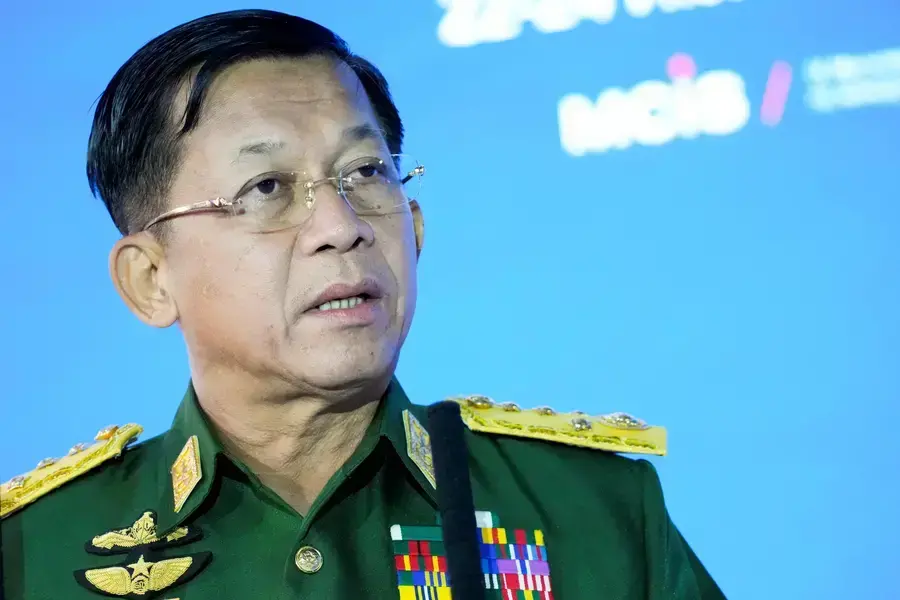The Bottom Is Falling Out for Myanmar’s Junta

Already facing a long string of battlefield defeats, defections, and loss of territory, in recent weeks, the Myanmar military seems to have reached a crossroads, in which several events suggest the bottom could be falling out for the junta—and that both Myanmar citizens and outsiders should prepare for an endgame. Scenarios could include a potential fracture in the junta, last-ditch attempts by the military to take back territory using even more brutal tactics, or other endgame scenarios that have occurred in similar situations, such as senior officers trying to flee, trying to ensure their assets in and out of the country are safe, and even looking for third countries to take them.
The allied opposition has put increasing military pressure on the junta for a long time, but significant breakthroughs are now occurring on a much more rapid timeline. The junta has lost Myawaddy, a critical town on the border with Thailand, to the opposition forces. Not only is this a major psychological defeat, but it potentially opens a corridor for the opposition to move aid, men, or other equipment through Thailand, provided the Thai government, increasingly skeptical of the junta’s chances, allows it.
More on:
The opposition has also stepped up attacks in areas the junta thought (wrongly) it could enjoy safety, sending the message to Myanmar citizens, regular army troops, and top leaders that it can hit the army anywhere. Recent drone strikes by the opposition forces military’ purpose-built, supposedly impregnable capital of Naypyidaw did not cause that much damage. Still, they likely inflicted a severe psychological blow, showing that the opposition can attack even in the capital, as well as in other parts of the central, majority Bamar heartland of Myanmar.
The military is also taking increased losses in western Myanmar to the powerful opposition Arakan Army. Its effective control of vast portions of the country is now diminishing, and even in the central Bamar areas, it is unclear whether the military has control of anywhere other than urban centers.
Plus, they are now experiencing much larger defections and surrenders. They see the opposition emboldened to hit them in bigger battles in more critical locations and even attempt to strike at military service academies. Attacks and assassinations on higher-level figures in the junta also are becoming more common.
According to the Washington Post, defectors say the junta has minimal rations to feed its men, other than the top ranks, and it is running low on crucial military supplies. Meanwhile, the parallel social welfare network that has always been attractive for men and families to join the military has completely broken down and is of no use or attraction at all anymore. Soldiers are desperate, and the veil of isolation imposed by the junta to keep them oblivious to the fact that it was losing and that the opposition forces are not “terrorists” or some other terrible entity is breaking down as defections rise.
Besides Russia, which can still offer some supplies but needs most of its armaments for its own wars, what countries will resupply the junta—or even stand behind it diplomatically anymore? Russia has even asked the junta to send back some of the weapons it gave the Myanmar military since Moscow needs them for the Ukraine war. Fewer and fewer of the junta suppliers can arm it—even North Korea is more focused on supplying weapons to Russia. Regarding diplomatic relations, while ASEAN has not covered itself in glory since the coup, there seems to be a shift among some Southeast Asian states in their views of the junta and its longevity. Indeed, even ASEAN states that were on the fence about the junta, like Thailand, now seem to be almost predicting its demise, or at least preparing for it. (Several ASEAN countries, like Malaysia and Indonesia, have been critical of the military, at times, for the past three years.) Even China, which has diplomatically protected the junta, seems increasingly frustrated with its failures and the resultant spillover into China; the opposition now controls vital areas on both the Thai and Chinese borders.
More on:
How long can the junta hold out? Indeed, a range of possibilities should be considered in a possible endgame. Will the military move Aung San Suu Kyi and other high-level prisoners into house arrest, as already appears to have happened with Suu Kyi, perhaps to use them to create some face-saving measure in which the army backs down but is not held accountable for its abuses and crimes? Or, even worse, use the high-level prisoners as possible human shields? With defections rising even among flag officers, will the junta split, with some senior leaders rebelling against junta chief Min Aung Hlaing? Will top military figures begin planning to flee the country, and to where? Will they intensify their focus on gathering assets and finding somewhere to stash them, if possible? Will an opposition victory on an even larger scale—combined with greater knowledge among ordinary soldiers of their dire state—lead to such enormous defections (and massive migrations within Myanmar and out of the country) that the junta can no longer fight? At this point, all of these options and other endgame scenarios must be taken seriously.
 Online Store
Online Store